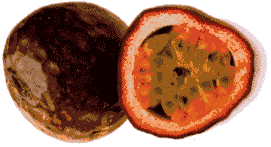|
|
 Guava and Feijoa Guava and Feijoa
Tropical fruit having a light
yellow or green skin and white, pink or dark-red edible flesh.
Guavas are apple- or pear shaped.
The Guava tree can grow up to
12 cm. long;
Guava tastes like a combination
of pear and strawberry;
The seeds of guavas are edible;
The feijoa is the guava's brother.
It is green and more elongated.
A specific type of Feijoa is the pineapple guava.
Are tropical fruit so do not keep
them in the refrigerator (see bananas).
Guavas and feijoas can be kept for a few days on a fruit bowl at room temperature.
Are a big type of berry.
Do not peel guavas because the
edible rind contains a lot of vitamin C (five times more than an orange).
The major producers of guava in
the world are India, Brazil, and Mexico.
Are great thirst quenchers and
contain very much vitamin C. and much iron.
Nutrition Facts
Selection
Recipes
Acidity
For more about the guava check out: Guava
the "best" fruit
 Kiwano Kiwano
The horned
melon.
Is a member
of the cucumber family and not of the kiwi family.
Looks like
an oval melon with horns and is very decorative.
Picked green,
riped orange, the kiwano tastes like a mix oflemon and banana.
It is a
tropical fruit so it cannot be stored in the refrigerator.
Nutrition Facts
Selection
Recipes
Acidity
 Kiwi
Fruit Kiwi
Fruit
Small oval
fruits with a thin brown skin, soft green flesh and black seeds.
Kiwis are
originally from China and were improved in New Zealand
Kiwis contain a protein-splitting enzyme. Other fruit that contains this enzyme are fresh papaya, pineapple and babaco. This substance makes the fruit easy to digest and fried together with meat it makes it more tender. If you put this fruit in dairy products it will make them watery. If the fruit is cooked like all canned and other processed fruit this enzyme is no longer active.
Kiwis are
a subtropical and not a tropical fruit. Therefore it is best to store them
in the fridge.
To make
them ripe faster you can keep them in a closed plastic bag together with
an apple, pear or banana. These fruits excrete ethylene gas which fastens
the riping of kiwis and avocadoes.
Nutrition Facts
Selection
Recipes
Acidity
For more about the kiwi and the yellow kiwi check out: Zespri.com
 Papayas
/ Paw Paw Papayas
/ Paw Paw
An orange
coloured fleshy fruit.
Are often
called tree-melons.
Can grow
to 6 kg. a fruit.
Unripe fruits
can be eaten as a vegetable but ripe fruits always contain more vitamins
and minerals.
Eat papayas
peeled.
Papayas contain a protein-splitting enzyme. Other fruit that contains this enzyme are fresh kiwi, pineapple and babaco. This substance makes the fruit easy to digest and fried together with meat it makes it more tender. If you put this fruit in dairy products it will make them watery. If the fruit is cooked like all canned and other processed fruit this enzyme is no longer active.
Treat them
like melons.
Contain
vitamin B, C. and iron.
Nutrition Facts
Selection
Recipes
Acidity
 Passion
Fruit Passion
Fruit
Edible fruit
of certain types of passion-flower.
Can be purple
or yellow.
Has a tranquilizing
effect on your body. Eat them before you go to sleep and you will dream
sweet dreams.
You can
store them for a few days in the refrigerator. Passion fruits are mostly
sold when they are ripe.
Contains
much vitamin B, C and much iron.
Nutrition Facts
Selection
Recipes
Acidity
 Pomegranate Pomegranate
Thick-skinned round fruit which,
when ripe, has a reddish centre full of large juicy seeds.
This fruit is sold yellow-red
and is ripe when it is red-brown.
You can keep it several weeks
at room-temperature or in the refrigerator.
Watch out for stains, they are
hard to remove.
Grenadine is made out of pomegranates.
The most delicious type of pomegranate
comes from Iraq.
Contains much vitamin C, B and
much iron.
Nutrition Facts
Selection
Recipes
Acidity
Home
- Fruits - Tropical
Fruit - More
than 15 seeded fruit
|